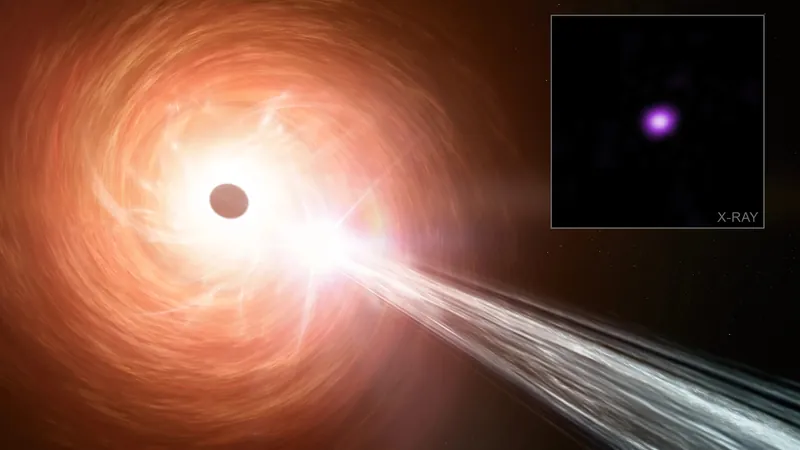
Unbelievable Discovery: Black Hole Defies Limits, Grows 2.4 Times Faster Than Theories Allow!
2025-09-20
Author: Noah
Astronomers Uncover a Cosmic Mystery
In a groundbreaking revelation, astronomers have located a colossal black hole from the early universe feasting on matter at an astonishing rate—2.4 times faster than the theoretical limits allowed. This discovery intensifies the enigma surrounding the rapid expansion of some black holes that emerged shortly after the Big Bang.
Meet RACS J0320-35: The Unstoppable Black Hole
Using NASA's Chandra X-ray Observatory, scientists honed in on an ancient black hole known as RACS J0320-35, which formed a mere 920 million years post-Big Bang. Even at that primitive stage of cosmic evolution—when the universe was just one-fifteenth its current age—this black hole had already ballooned to an incredible mass, hitting roughly 1 billion times that of our sun.
Breaking the Eddington Barrier
A recent analysis of X-ray, infrared, and optical emissions from the black hole reveals an astonishing growth rate that surpasses the Eddington limit, a theoretical cap dictating how rapidly black holes can accumulate matter based on their gravitational forces and radiation pressure. Lead researcher Luca Ighina expressed disbelief, stating, "It was a bit shocking to see this black hole growing by leaps and bounds."
Why This Discovery Matters
While RACS J0320-35 isn't the first super-Eddington black hole found in the universe's early stages, further investigation could help unravel why certain ancient black holes seem to defy the laws of cosmology. Published on September 8 in The Astrophysical Journal Letters, this research posits that rapid growth might be more common in the cosmos than previously believed.
The Mechanics of Black Hole Growth
Black holes are not just cosmic voids; they are formed from the collapse of massive stars, creating gravitational wells that devour surrounding matter. They gain mass through two primary mechanisms: merging with other black holes and consuming vast amounts of matter that drift too close to their event horizon.
RACS J0320-35 Shines Bright
As massive black holes like RACS J0320-35 draw in material at near-light speeds, they emit dazzling bursts of energy, often appearing as quasars that can outshine entire galaxies. First detected in a radio telescope survey, this black hole's brilliant emissions make it an exceptional target for astronomers seeking to understand black hole growth.
A Closer Look at Its Growth Rate
By examining the intensity of X-ray emissions and comparing them to infrared and optical data, researchers estimated that this black hole consumes between 300 to 3,000 solar masses annually, far exceeding the Eddington limit. The question remains: how can such a black hole grow at this phenomenal rate without destabilizing?
What’s Next for Black Hole Research?
With insights into RACS J0320-35's growth and age, the team theorizes that it initially formed from the collapse of a supermassive star. Findings from other super-Eddington black holes detected by the James Webb Space Telescope suggest that these fast-growing giants could be more commonplace in the ancient universe than current models indicate.
With ongoing research, scientists aim to unlock the secrets behind the formation of these primordial black holes and understand their incredible growth, questioning the very foundations of our understanding of the cosmos.









 Brasil (PT)
Brasil (PT)
 Canada (EN)
Canada (EN)
 Chile (ES)
Chile (ES)
 Česko (CS)
Česko (CS)
 대한민국 (KO)
대한민국 (KO)
 España (ES)
España (ES)
 France (FR)
France (FR)
 Hong Kong (EN)
Hong Kong (EN)
 Italia (IT)
Italia (IT)
 日本 (JA)
日本 (JA)
 Magyarország (HU)
Magyarország (HU)
 Norge (NO)
Norge (NO)
 Polska (PL)
Polska (PL)
 Schweiz (DE)
Schweiz (DE)
 Singapore (EN)
Singapore (EN)
 Sverige (SV)
Sverige (SV)
 Suomi (FI)
Suomi (FI)
 Türkiye (TR)
Türkiye (TR)
 الإمارات العربية المتحدة (AR)
الإمارات العربية المتحدة (AR)